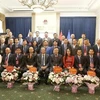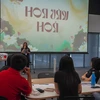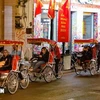Khuat Viet Hung, Vice-Chairman of the National Traffic Safety Committee, told Vietnamplus.vn that though less traffic accidents have occurred so far this year, overloaded trucks pose a safety threat.
* What are your assessments on traffic accidents for the first six months?
With concerted efforts from both political and administrative systems, traffic accidents have been reduced considerably in terms of cases, fatalities and injuries.
There were 11,179 traffic accidents reported in the period under review, of which 4,478 people were killed and 10,149 injured. Compared with the same period in 2014, the number of total accidents was down by 12.85 percent – or 1,648 cases.
The death rate also fell by 4.5 percent – a reduction of 211 cases - and the number of people injured was 17.24 percent – a reduction of 2,114.
Judged by the criteria set down by the National Assembly and Government, the fall in traffic accidents and injuries was positive. However, fatalities were 0.5 percent below the set target of a five to 10 percent reduction.
* In your opinion, what's the weakest point in the programme for traffic safety?
The Government issues monthly resolutions on the traffic safety tasks. According to reports from the National Traffic Safety Committee (NTSC), in the first six months, traffic safety in a few localities faced some acute problems.
For example, overloaded trucks for the whole of 2014 accounted for about 8 percent of traffic violations. However, in the first six months of this year, this figure jumped to 30 percent.
The number of drivers driving under the influence of alcohol jumped to 2.4 percent in the first six months against 0.49 percent in 2014.
However, from December, 2014, to February, 2015, the NTSC launched a campaign on traffic safety. In that short period, the number of drivers driving over the legal alcohol limit accounted for only 6.8 percent of total traffic violations.
* Although the number of traffic accidents was reduced, the number of serious cases rose. How do you respond to this?
I have to concede the number of accidents has is creating great concern in society. Generally speaking, fatalities caused by buses, coaches and trucks were reduced. But the number of accidents involving buses and coaches or container trucks with other means of transport were on the rise.
Accidents in rail transport in the first six months of 2015 were on the increase compared with the previous few years.
In the first five months of 2015, 22 accidents involved container trucks, of which 11 were in HCM City, two in Binh Duong, two in Dong Nai, three in Ba Ria - Vung Tau. Meanwhile, in Hai Phong, the second busiest port after HCM City, the number of accidents caused by container trucks was only two.
* Does the NTSC have any plan to curb accidents caused by transport vehicles, particularly container trucks?
In the remaining six months of 2015, we plan to step up inspections on transport vehicles nation-wide, particularly on overloaded trucks.
We'll ask all transport companies to submit black-boxes recording vehicle trips for the previous month for checking. Data from these black boxes will help us check whether these companies comply with the laws or not.
Meanwhile, we're determined to bring law and order to the transport sector, including road, rail and sea. Hopefully, through the restructuring of the transport sector, it will become healthy balance of road, rail and sea.
* Will you tell us about the transport safety plan for the remainder of 2015?
The most important activity of the NTSC in this period is to tighten the transport business. As we all know, damage and losses caused by traffic accidents have become a nightmare to many people and society as a whole.
This is why, for two consecutive years, the NTSC has focused efforts on controlling the transport business and overloaded vehicles.
In addition, safety transport corridor will receive attention from the NTSC to ensure transport safety when our transport infrastructure have been up-graded.
Last but not least, communication and raising people's awareness about transport safety will further be promoted. We consider this a very important component in transport safety.-VNA
* What are your assessments on traffic accidents for the first six months?
With concerted efforts from both political and administrative systems, traffic accidents have been reduced considerably in terms of cases, fatalities and injuries.
There were 11,179 traffic accidents reported in the period under review, of which 4,478 people were killed and 10,149 injured. Compared with the same period in 2014, the number of total accidents was down by 12.85 percent – or 1,648 cases.
The death rate also fell by 4.5 percent – a reduction of 211 cases - and the number of people injured was 17.24 percent – a reduction of 2,114.
Judged by the criteria set down by the National Assembly and Government, the fall in traffic accidents and injuries was positive. However, fatalities were 0.5 percent below the set target of a five to 10 percent reduction.
* In your opinion, what's the weakest point in the programme for traffic safety?
The Government issues monthly resolutions on the traffic safety tasks. According to reports from the National Traffic Safety Committee (NTSC), in the first six months, traffic safety in a few localities faced some acute problems.
For example, overloaded trucks for the whole of 2014 accounted for about 8 percent of traffic violations. However, in the first six months of this year, this figure jumped to 30 percent.
The number of drivers driving under the influence of alcohol jumped to 2.4 percent in the first six months against 0.49 percent in 2014.
However, from December, 2014, to February, 2015, the NTSC launched a campaign on traffic safety. In that short period, the number of drivers driving over the legal alcohol limit accounted for only 6.8 percent of total traffic violations.
* Although the number of traffic accidents was reduced, the number of serious cases rose. How do you respond to this?
I have to concede the number of accidents has is creating great concern in society. Generally speaking, fatalities caused by buses, coaches and trucks were reduced. But the number of accidents involving buses and coaches or container trucks with other means of transport were on the rise.
Accidents in rail transport in the first six months of 2015 were on the increase compared with the previous few years.
In the first five months of 2015, 22 accidents involved container trucks, of which 11 were in HCM City, two in Binh Duong, two in Dong Nai, three in Ba Ria - Vung Tau. Meanwhile, in Hai Phong, the second busiest port after HCM City, the number of accidents caused by container trucks was only two.
* Does the NTSC have any plan to curb accidents caused by transport vehicles, particularly container trucks?
In the remaining six months of 2015, we plan to step up inspections on transport vehicles nation-wide, particularly on overloaded trucks.
We'll ask all transport companies to submit black-boxes recording vehicle trips for the previous month for checking. Data from these black boxes will help us check whether these companies comply with the laws or not.
Meanwhile, we're determined to bring law and order to the transport sector, including road, rail and sea. Hopefully, through the restructuring of the transport sector, it will become healthy balance of road, rail and sea.
* Will you tell us about the transport safety plan for the remainder of 2015?
The most important activity of the NTSC in this period is to tighten the transport business. As we all know, damage and losses caused by traffic accidents have become a nightmare to many people and society as a whole.
This is why, for two consecutive years, the NTSC has focused efforts on controlling the transport business and overloaded vehicles.
In addition, safety transport corridor will receive attention from the NTSC to ensure transport safety when our transport infrastructure have been up-graded.
Last but not least, communication and raising people's awareness about transport safety will further be promoted. We consider this a very important component in transport safety.-VNA



















